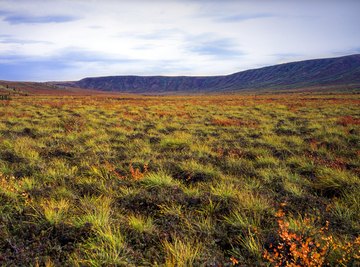
The North Pole is typically thought of as a place of snow and ice where nothing grows. However, the North Pole is home to the unique and vibrant Arctic ecosystem. North Pole animals and plants coexist in the harsh biome, although climate change has introduced new dynamics.
TL;DR (Too Long; Didn't Read)
Rather than being strictly a region of snow and ice, plants reside in the North Pole region. The tundra biome of the Arctic is home to several species of plants with special adaptations for the short growing season and cold temperatures.
Characteristics of the Tundra Biome
The North Pole region, or the Arctic, represents the tundra biome. The word 'tundra' derives from a Finnish word, tunturia, meaning barren land without trees. The tundra is as far north as any plant can grow. It is a desert-like environment with little precipitation. The precipitation for this climate reaches only about 15 inches annually.
The tundra is dry and cold, and its winters are long while its summers are brief. The growing season of the tundra biome averages only about 60 days. Low temperatures in the Arctic can reach -30 degrees Fahrenheit in winter, although summer warms as much as 54 degrees Fahrenheit.
Beneath thin soil, permafrost can be found in the tundra. Permafrost is ground that is permanently frozen. Having this frozen ground beneath soil creates a challenge for root development.
All of these characteristics make the tundra a harsh place for life, yet it does exist. Any precipitation can pool on the permafrost to provide moisture for plants, but it does not drain well.
What Plants Live in the Arctic?
Approximately 1,700 known species of plants live in the Arctic and subarctic areas of the North Pole. Many of these plants are stunted and grow low to the ground. This adaptation aids in their survival against the brutal winds and bitter temperatures at the North Pole. The plants of the North Pole have adapted to the low light and cold temperatures and are still able to carry out photosynthesis.
Plants of the North Pole tend not to reproduce via flowers due to the short growing season. Often, these plants use budding as a form of reproduction. Some examples of North Pole plants include sedges, grasses, over 400 flower varieties, reindeer mosses, liverworts, shrubs and cushion plants. The North Pole is also home to some lichens.
The plants of the North Pole provide food for the animals that live in the Arctic. Herbivores of the Arctic include lemmings, voles, caribou, hares, squirrels, insects, birds and fish. Carnivores, in turn, feed upon the herbivores. Since food is not abundant, many animals of the North Pole consume their food in summer and store more fat than southern animals so they can hibernate through the long winter.
Are There Trees in the Arctic?
Because of permafrost and a short growing season, the Arctic does not provide suitable habitat for tall trees. Any North Pole trees that do exist are dwarf trees. Some examples of trees in the North Pole include birches and willows.
One species of North Pole tree is the Arctic willow (Salix arctica). The catch is that it usually only grows as tall as ten centimeters and is, therefore, one of the smallest willows. The Arctic willow undergoes fall color change and grows in clumps.
Climate Change and North Pole Plants
Over the past 30 years, climate change has led to increases in the height of North Pole plants. This height increase, in turn, creates a method of snow entrapment that prevents the soil beneath from freezing as efficiently.
Scientists estimate that plants could increase their height by 60 percent over the next several decades. The reason for concern is that the permafrost contains up to 50 percent of the world’s carbon in the soil, so its thawing could lead to an increase in greenhouse gases in the atmosphere.
Various dynamics are at play due to climate change in the Arctic. Plants that lived at more southern latitudes are now spreading through the North Pole, such as vernal sweetgrass.
As plant communities change, so will the animals that forage on them. There is a likelihood of increased precipitation as the Arctic warms, which would affect soil moisture. More research is needed to study the effects of climate change on the plants of the North Pole.
References
About the Author
J. Dianne Dotson is a science writer with a degree in zoology/ecology and evolutionary biology. She spent nine years working in laboratory and clinical research. A lifelong writer, Dianne is also a content manager and science fiction and fantasy novelist. Dianne features science as well as writing topics on her website, jdiannedotson.com.
